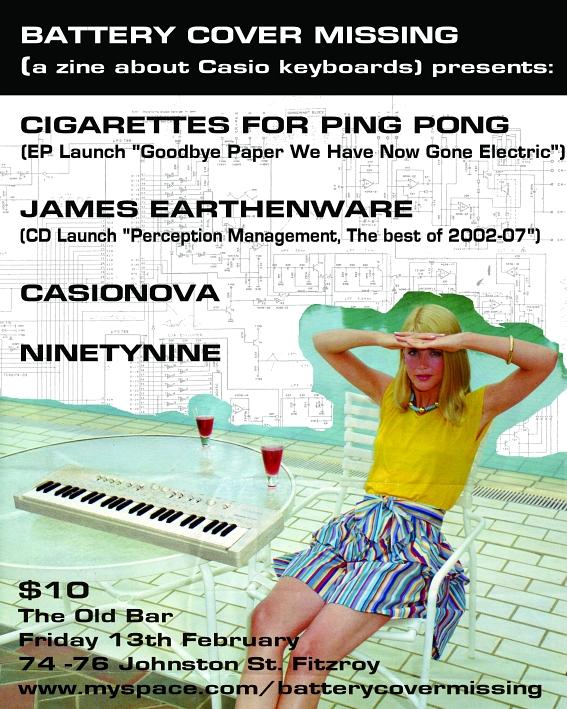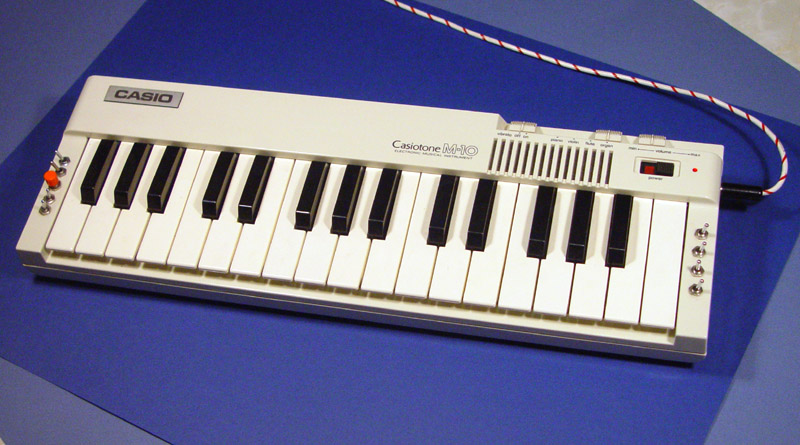There was a gig on 2009 February 13th: http://www.myspace.com/batterycovermissing focusing on 1980 to 1985 Casios!

In 1980 I purchased a Casio M10, the first battery operated, portable, polyphonic digital keyboard. In the next year or two I developed modifications for this, the MT-30 and the MT-40. After producing two photocopied booklets, I published the modification iinstructions in an offset-printed booklet and sent them to 300 or more people around the world who wrote to me, with a small payment. I got a very nice collection of appreciative letters and stamps! Publicity was via "New Products" announcements in some music magazines, but I think the biggest response came from professional electronic magazines.
Devo used a modified Casio - an MT-30 I guess. Maybe they were used in famous pieces of music, such as Thriller ("froggie casio" notes ). They were used by lots of people having a lot of fun making their own music, often in places it had never been made before. I took mine into a well on a farm, with a flanger and a transistor radio as an amplifier. They could be swung around at arm's length, giving Doppler shift, while playing a chord. (I have a key-ring on my VL1 and I think VL5 so they could be swung around on a piece of string.)
My
M10 is still going strong - it is beautifully made, with a steel
chassis. All Devil Fishes are tested
with this machine as an audio source.
The PDF of the 1981 booklet MODIFYING THE CASIOTONE INSTRUMENTS is here: casio-mod-01.pdf (31 Megabytes)
This is a PDF from TIF files which are scans of the offset printed booklet. See the sys-admin directory of this site for how to make PDFs from TIFs. (The three update pages 14 to 16 are from a computer file.) The booklet was printed on 4 sheets of A3 and folded together. The diagrams on page 13 were in the middle of the booklet, on an A3 sheet. The artwork for the booklet was done with a 1959 Kenro process camera (sadly gone to scrap in 2006 ... I kept the lens) and the typesetting was produced in that camera (onto Agfa "bromide" Copyproof ) by reducing largish pieces of paper printed with an IBM golfball typewriter. This was not an ordinary typewriter. It used to be the console of an IBM 360 mainframe computer. (This was before CRTs - the 1960s. A pair of 360s ran Houston Mission Control for the moonshots, with a clock rate of 500kHz, I think and 256 k bytes of RAM.) The printer just had a bunch of solenoids to control the mechanism, which is entirely mechanical an based on the entirely mechanical IBM golfball typewriter. I built hardware to drive the solenoids from a Z-80 PIO, and then some driver software to convert ASCII codes to the correct commands for how far to spin and tilt the ball. It printed 10 characters a second, used a film ribbon if I wanted good quality. All mechanics was driven by a 240 volt motor. The text was written on Wordstar 3.3 on a Z-80 machine. This was on my home-built machine which ran Cromemco CDOS, rather than the more common Digital Research operating system. I later ran a Big Board (1) with CPM. Anyway, I picked up the IBM golfball printer from a computer service company in Sydney, along with a bunch of gold-bearing circuit board and connectors and a block of 64kbytes of magnetic core memory, on the pretext I wanted them for a stage-set for the band I was in (Equal Local). The real reason for getting most of this was to extract the gold from the connectors and sell it for scrap - only a few people were onto it then. Anyway, the golfball printer worked nicely from Wordstar, and there were various balls which could be put on it, with various typefaces. There was no proportional spacing, as with a daisy-wheel, but I there were advanced IBM golfball typewriters which people used for low-cost typesetting. The fancy balls were made for those, but fitted the old 360 console printer.
A
moment's silence for the printers I owned and sadly, have no more:
A Creed
7B baudot teleprinter (1940s, once seen printing a telegram in a
Humphrey Bogart movie), the IBM golfball and two Diablo
Daisywheels - beautiful devices with fiendish TTL-based
digital servos for the carriage and daisywheel DC motors - I had one
left, but it was destroyed in a flood. (Googling indicates these
extraordinary machines from the late 1970s are quite obscure now.) An
old Tally 15" printer and a washing-machine sized Hitachi printer from
the 1980s - too big to keep, it had to go. I still have a
piano-sized Benson plotter.
Also, a text file which
describes how to give commands to the upD931 chip, as found in the
Casio MT-65.
